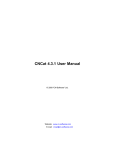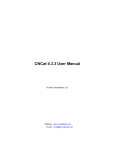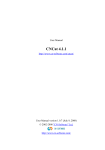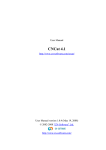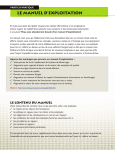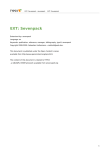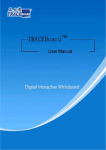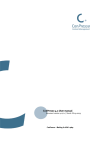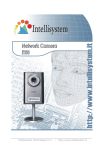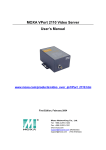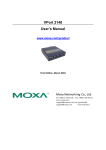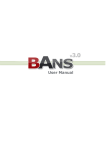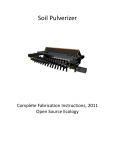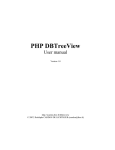Download CNCat 4.1.2 User Manual - CN
Transcript
CNCat 4.1.2 User Manual
© 2008 CN-Software
2
CNCat 4.1.2 User Manual
Table of Contents
Part I Program Overview
4
Part II CNCat Installation
4
1 Initial ...................................................................................................................................
Installation
4
2 Upgrading
...................................................................................................................................
Previous Versions
10
Upgrading CNCat
..........................................................................................................................................................
4.0
10
Installing CNCat
.........................................................................................................................................................
4.1 over 4.0
10
Installing CNCat
.........................................................................................................................................................
4.0 into Separate Database
10
Updating Design
.........................................................................................................................................................
Themes
11
Upgrading CNCat
..........................................................................................................................................................
3.1, 2.1, 2.0, 1.4
12
Importing Data
.........................................................................................................................................................
from Old Database Directly
13
Importing Data
.........................................................................................................................................................
from XML
13
Importing Design
......................................................................................................................................................... 14
15
Part III Catalogue User Interface
1 Main ...................................................................................................................................
User Interface Elements
16
2 Adding
...................................................................................................................................
Link
19
Add Wizard .......................................................................................................................................................... 19
One-step Add..........................................................................................................................................................
Link Form
22
3 Adding
...................................................................................................................................
Article
24
4 Search
...................................................................................................................................
26
5 Broken
...................................................................................................................................
Link Warning
26
27
Part IV Administrator Interface
1 Links...................................................................................................................................
and Articles
27
Working with ..........................................................................................................................................................
Links and Articles
28
New Links/Articles
.......................................................................................................................................................... 32
Submitted Links/Articles
.......................................................................................................................................................... 32
Deleted Links/Articles
.......................................................................................................................................................... 32
Drafts
.......................................................................................................................................................... 32
Warnings
.......................................................................................................................................................... 33
Search
.......................................................................................................................................................... 33
Processing Links
.......................................................................................................................................................... 34
Duplicated Links
.......................................................................................................................................................... 38
Adding Links .......................................................................................................................................................... 38
Adding Articles
.......................................................................................................................................................... 41
Adding Image..........................................................................................................................................................
for Link/Article
41
2 Catalogue
...................................................................................................................................
Elements
42
Categories .......................................................................................................................................................... 42
Filters
.......................................................................................................................................................... 46
Managing Images
..........................................................................................................................................................
in Database
47
Managing Banners
.......................................................................................................................................................... 49
3 Settings
...................................................................................................................................
51
© 2008 CN-Software
Table of Contents 3
Catalogue
.......................................................................................................................................................... 51
Links
.......................................................................................................................................................... 53
Articles
.......................................................................................................................................................... 55
RSS-feed
.......................................................................................................................................................... 56
Checking Links
.......................................................................................................................................................... 57
E-mail Notifications
.......................................................................................................................................................... 58
Uncontrolled ..........................................................................................................................................................
Jumps Protection
60
Backward Link
.......................................................................................................................................................... 61
'Black' List .......................................................................................................................................................... 62
Moderators .......................................................................................................................................................... 63
Counters
.......................................................................................................................................................... 64
Service Options
.......................................................................................................................................................... 65
Importing
.......................................................................................................................................................... 66
Exporting
.......................................................................................................................................................... 67
Part V Catalogue Management: Additional Options
1 Site Map
...................................................................................................................................
Part VI Appendix A: Design Themes
68
68
69
1 Theme
...................................................................................................................................
Files and Templates
69
2 Templates
...................................................................................................................................
File Format
76
Inclusion of Generated
..........................................................................................................................................................
HTML-Code
77
Inclusion of Another
..........................................................................................................................................................
Template
77
Variables Display
.......................................................................................................................................................... 77
Conditions .......................................................................................................................................................... 78
Function Call .......................................................................................................................................................... 78
© 2008 CN-Software
3
4
1
CNCat 4.1.2 User Manual
Program Overview
CNCat application is intended to create a catalogue of Internet resources and articles. The program is easy to
install, to set up, and to maintain. Its functionality includes:
· Adding, editing, and deleting links and articles;
· Checking links;
· Filtering links (“through categories”);
· Creating “black”/“white” lists of links;
· Creating and editing categories of unlimited nesting level;
· Creating cross-categories;
· Exporting data into RSS;
· Searching through the catalogue;
· Automatic e-mail notifications;
· Administering module with moderators involved;
· A set of templates for interface configuration;
· Importing links and formatting themes from the previous CNCat versions.
To start make CNCat function, you should have PHP and MySql. The application supports multi-language
interface (the distribution kit includes: Russian, Ukraine, English, and Czech languages).
Note: This manual describes the principles of working with the catalogue within the bounds of the program
interface as well as design themes editing. Also, please see Useful Articles (HOWTO)
2
CNCat Installation
Initial Installation
Upgrading Previous Versions
2.1
Initial Installation
To install CNCat, do the following:
© 2008 CN-Software
CNCat Installation
5
1.
Download CNCat from the official website: http://www.cn-software.com/cncat.
2.
Extract the files from the archive and then place them into any directory of your site (you can place the
files into the root directory).
3.
Run the installer. To do this, specify the path to folder /install/ in the Browser address field. For
example, http://www.server.com/cncat/install/. As a result, the installation wizard will appear in the
screen.
In case you are running the update of the previous CNCat version and there is a ‘config.php’ file located in /
cncatconfig folder, then you will be asked to log in as and administrator first.
Administrator Login
At the first step, select the installation language:
Selecting Interface Language
At the second step, you should accept the License Agreement to continue installation:
© 2008 CN-Software
6
CNCat 4.1.2 User Manual
License
Agreement
Then, the wizard will check your server configuration for conformance with the system requirements:
Check Results
Next, you will be prompted to configure connection settings (some parameters are set up automatically):
Connection Settings
Specify the following parameters on this form:
· MySql: server, login name, password – data for establishing connection with MySql server. Enter
© 2008 CN-Software
CNCat Installation
7
data you have or data you’ve got from the hosting provider or databases server administrator.
· Database name – database name. You can choose any name here.
· Prefix for CNCat tables – a prefix for CNCat database tables names (by default, ‘cncat41_’).
Click Next. The installer will check you workstation for the existing version of CNCat. In case the current CNCat
version is found you your computer, you will be prompted to delete all the existing program tables and install
CNCat one more time (to do this, check the corresponding checkbox, and then click Next). To ignore this
update and to leave everything as is, click Cancel.
Updating Current Version of CNCat
In case the installation wizard finds the old version of CNCat, then you will be prompted:
· either to update the old version up to the current one;
· or delete the tables of the old version and install the new one:
Updating the Old CNCat Version
© 2008 CN-Software
8
CNCat 4.1.2 User Manual
Click Next, to install new version of the program.
At the next step, the wizard will display the form to set up catalogue parameters:
Setting up Catalogue Parameters
Specify the following parameters on this form:
· Interface settings: interface language, language of the catalogue content – select program
interface language and .the language of the catalogue resources.
· Theme: default, classic, simple - select graphical design theme of the catalogue.
· Administration: login name, password – data necessary for catalogue administering.
Click the Next button and the wizard will create all required tables in the database. In case the database does
not exist, the installer will try to create it.
Then, the installation wizard will display the 'config.php’ file content. You should create this file manually and
place it into the catalogue the CNCat is installed in, and then insert the result code:
© 2008 CN-Software
CNCat Installation
9
Configuration File Code
Provided the previous step has been completed correctly, the wizard will display the message about
successful installation completion (otherwise, the code for ‘config.php’ file will be displayed again). After that,
delete /install/ folder from the server. To start working with the catalogue, specify the path to the catalogue
interface in the Browser address field (for example, http://www.server.com/cncat/), or use the link on the
installation form:
Installation Completion
After installation has been completed, go to administrator interface (see paragraph Administrator Interface)
and enter License key there. Get free or commercial key at website: http://www.cn-software.com/ru/cncat/
Form for License Submission
Enter the full license code into the text field and then click the Save button. After your license has been
accepted, you will be able to access all the other administrator page sections and to manage your catalogue.
© 2008 CN-Software
10
2.2
CNCat 4.1.2 User Manual
Upgrading Previous Versions
Upgrading CNCat 4.0
Upgrading CNCat 3.1, 2.1, 2.0, 1.4
2.2.1
Upgrading CNCat 4.0
Important! Before upgrading, save a backup copy of all data (Administering – Settings – Export). In case the
upgrade is incorrect, you will be able to restore all data using the backup copy.
If the current CNCat version is 4.0, or 4.0.1, or 4.0.2, then there are two ways to move to CNCat v4.1.
The first one (recommended) – installation over the old catalogue. You should copy new files over the old ones
and then run the installation in the CNCat 4.0 Upgrade mode. The database will be automatically upgraded.
The second way is to install new version into the separate folder and database. After installation is over, you
should import data from the old database and copy configuration files from the previous version.
Both upgrade methods are described in the following paragraphs.
Note: If you’ve modified the catalogue formatting, you should modify the theme to enable new functions.
__________
Installing CNCat 4.1 over 4.0
Installing CNCat 4.0 into Separate Database
Updating Design Themes
2.2.1.1
Installing CNCat 4.1 over 4.0
Save the backup copy of the database. To do this, export data from the old version into the XML-file (
Administration – Settings – Export).
Copy new version files over the old files. Run the installation (see paragraph Installation).
While installing, you will be prompted to upgrade the old version. Select one of the methods: update the
already installed version or delete program tables and install new version (see Update Old Version figure). In
the latter case all the data will be deleted.
2.2.1.2
Installing CNCat 4.0 into Separate Database
Install CNCat 4.1 into the separate folder and new database (see paragraph Installation). You can use the
same database, but the different tables prefix, for example ‘cncat41_’:
1.
In the administrator interface, select the Settings – Import – Import from CNCat 4.x – Import from
XML and database.
© 2008 CN-Software
CNCat Installation
2.
Specify database name and tables prefix of the previous version.
3.
Click Import.
11
Note: The importing process can take some time. When importing, information on the amount of already
imported data is displayed.
For more information on data importing, see paragraph Importing.
2.2.1.3
Updating Design Themes
If you use the modified formatting theme, you should change it to enable new functions of the catalogue.
New themes have been significantly modified, that is why, if you are using one of the standard themes with
your modifications, we recommend to modify the newly updated theme in the same way.
If the standard theme has been radically modified, then do the following:
1.
Save a backup copy of your theme.
2.
Copy new files from the ‘default’ theme into your theme:
· editor.css
· add_article.tpl
· article.tpl
· extended_article.tpl
· /images/category-big.gif
· /images/rss.gif
3.
Copy file ‘add.tpl’ from the ‘default’ theme over the file of your theme.
4.
To enable the link ‘Add Article’: in ‘common.tpl’ file of the ‘menu’ template, substitute the string
{IF !$CNCAT[config][add_disable]}…
for:
{IF !$CNCAT[config][add_disable]}<a href="{$CNCAT[abs]}cncat_add.php"><strong>{$CNCAT[lan
{IF $CNCAT[config][add_article_enable]}<a href="{$CNCAT[abs]}cncat_add_article.php"><stro
5.
To enable section New Articles: in ‘index.tpl’ file of the ‘index’ template, after the string
{DISPLAY NEW_ITEMS}
add:
© 2008 CN-Software
12
CNCat 4.1.2 User Manual
<br>{DISPLAY NEW_ARTICLES}
Also, we recommend to copy ‘newitem*’ templates code from the standard theme.
6.
To enable the section for selecting the displayed elements of the catalogue All/References/Articles:
· Copy all ‘itemtype*’ templates from the file ‘common.tpl’ of the standard theme into the new
theme.
· In ‘index.tpl’ file of the ‘index’ template right before the string
{DISPLAY SORT}
add the following string
{DISPLAY ITEM_TYPES}<br>
7.
To enable RSS: in the ‘category.tpl’ file of the ‘catpath_currentcat’ template, add as the last string:
{IF $CNCAT[page][show_rss]}<a href="{$CNCAT[abs]}cncat_rss.php?c={$CNCAT[page][cid]}"><im
2.2.2
Upgrading CNCat 3.1, 2.1, 2.0, 1.4
Important! Before upgrading, save a backup copy of all data into XML-files (Administering – Settings –
Export). In case the upgrade is incorrect, you will be able to restore all data using the backup copy. For
more information, see your CNCat User Manual, paragraph ‘Exporting’.
To upgrade CNCat versions 3.x, 2.x, and 1.x, do the following:
1.
Save a backup copy for versions 3.x and 2.x – export data into XML-files (see the manual for your
current CNCat version, paragraph Exporting).
2.
Save the backup copy of all old catalogue files.
3.
Install the current version of CNCat into new folder and new database (or into the same database,
but with the different prefix for the tables. By default, the prefix was ‘cncat_’). For more information,
see paragraph Installation.
4.
Import data directly from the old database or from XML-files.
5.
You can also choose to import design from the old database.
6.
If you have modified the files ‘_top.php’ and ‘_bottom.php’ in the old version, then copy them into the
new version.
7.
Make sure the catalogue and its all functions work fine.
8.
Once you remove all old files, place the catalogue files into the old folder.
In the following paragraphs, the way data and design can be imported is described.
____________
© 2008 CN-Software
CNCat Installation
13
Importing Data from Old Database Directly
Importing Data from XML
Importing Design
2.2.2.1
Importing Data from Old Database Directly
To import data from the old database:
1.
Go to administrator interface, then select the Settings – Import – Importing from CNCat 3.x, 2.x, 1.x –
Importing from database.
2.
Specify the database name and table prefix. Open ‘config.php’ file of your old catalogue version to
get these values:
· $db["name"]="database name";
· $db["prefix"]="prefix";
3.
Click the Import button.
Note. The importing process can take some time. When importing, information on the amount of already
imported data is displayed.
2.2.2.2
Importing Data from XML
To import data from XML files:
1.
Go to administrator interface, then select the Settings – Import – Importing from CNCat 3.x, 2.x –
Importing from XML.
2.
Check the Clean the catalogue before importing field.
3.
Browse for the XML files if they are of a small size (1 Mb at most):
© 2008 CN-Software
14
CNCat 4.1.2 User Manual
Importing XML from Local Disk
If the files size is larger than 1 Mb, upload the files into the /cncat_export/ folder and then refresh the
import page. On the import form, check the Clean the catalogue before importing option:
Importing XML File from Server
4.
Click the Import button.
Note. The importing process can take some time. When importing, information on the amount of already
imported data is displayed.
2.2.2.3
Importing Design
New CNCat stores formatting in files, which is different from the CNCat version 3.1 and earlier. For more
information on formatting, see Design Themes manual.
Note 1. Importing design themes function is a trial one yet. After you import the themes, there can be slight
differences in the pages format comparing to the old catalogue version.
Note 2. If your current operating system is not Windows (for example, FreeBSD, or Linux), make sure PHP is
able to create folders and files in /cncat_config/themes/ folder. Consult your hosting support staff about these
abilities.
© 2008 CN-Software
CNCat Installation
15
To import formatting from the old catalogue, you should do the following:
1.
Go to administrator interface, and then select the Settings – Import – Importing from CNCat 3.x, 2.x –
Importing Design.
Importing Design from Previous Versions
2.
Specify the new theme name (this is how it will be displayed in the list of themes).
3.
Enter the old catalogue version database name and table prefix. These values are stored in the
‘config.php’ file of your catalogue old version:
· $db["name"]="database name";
· $db["prefix"]="prefix";
4.
Click the Import button.
Go to the Settings – Catalogue – General Settings. Make sure the design theme is displayed in the list (see
the Theme drop-down list).
3
Catalogue User Interface
Main User Interface Elements
Adding Link
Adding Article
Search
Broken Link Warning
© 2008 CN-Software
16
3.1
CNCat 4.1.2 User Manual
Main User Interface Elements
User interface consists of the following elements:
· Menu - links to catalogue main page, adding links form, adding articles form, administration page,
and XML site map (1).
· The catalogue search (2).
· Filters (3).
· The list of the catalogue categories (4).
· Links sorting (5).
· The complete list of all the catalogue links (6).
· Options allowing to select catalogue layout (all content, only links, only articles) (7).
· The list of new links (8) - displays the latest submitted links (the number of displayed links can be
set up via Administration - Settings - Catalogue page).
· The list of new articles (9) – displays the latest submitted articles (the number of displayed
articles can be set up via Administration - Settings - Catalogue page).
© 2008 CN-Software
Catalogue User Interface
17
· The path to the currently selected category and category’s name (10):
Main Catalogue Page
Note: The GUI design depends on the selected theme (see Catalogue).
Menu bar (1) allows you to add link, article, and to go to the administrator interface (see Administrator Interface)
and to the catalogue map.
Search engine (2) allows finding the required link in the catalogue efficiently.
Filters (3) are intended for sorting out the links list by various parameters (language, geography, resource type
etc.). The filtering parameters can be set up in the administrator interface; its number and variety of values are
unlimited. Several values of each filter can be selected for each link (see Filters).
The list of categories (4) includes the number of links contained in every category/subcategory. Each link can
be stored in one or more categories. Besides, it is possible to create cross-categories, which are links to
existing categories (see Categories).
A standard sorting mechanism (5) allows sorting links by popularity, name etc.
© 2008 CN-Software
18
CNCat 4.1.2 User Manual
There are the following parameters defined for each link in the list of all catalogue elements (6):
· jumps from/to the site (in brackets);
· the link rating in Google PR and Yandex CY;
· level of “favour” links (marked by “star” icons) (see Adding Link);
· brief description of the link;
· the link URL.
To view detailed description of a link, click on the icon
:
Detailed Link Description
The following parameters are specified for each article in the catalogue list (6):
· article title;
· abstract;
· source link.
To display the content, click on the article title:
© 2008 CN-Software
Catalogue User Interface
19
Article Contents
To inform the moderator about a link, which does not display its contents, click on the icon
3.2
(see Warnings).
Adding Link
There are two algorithms of adding links:
· By means of a wizard (recommended).
· By means of one-step form (brief variant).
The advantage of the wizard is in checking of a backward link while adding. To generate a backward link, you
should know its identifier, which is generated at the first step of the wizard. In one-step mode, the identifier
generation stage is omitted, therefore, backward link checking is possible only after adding the link into the
catalogue.
Setting of addition mode and parameters is performed in the administrator module (see Links)
The catalogue administrator, as well as moderators, can add links via administrator interface (see Adding
Links).
___________
Add Wizard
One-step Add Link Form
3.2.1
Add Wizard
To add a link, click on the Add link section in the menu bar; the following dialog box will appear on the screen
(see Wizard: Step 1 figure).
Note. The given example describes a standard set of adding parameters. It may differ, depending on the
settings specified at the administrator interface.
At the first step, you should specify the site name and address; enter the characters displayed in the image
(protection from automatic adding) and click the Next button:
© 2008 CN-Software
20
CNCat 4.1.2 User Manual
Wizard: Step 1
Provided that the previous step has been performed correctly, the wizard will display the next step of the link
adding.
Note. All the fields of the form are obligatory. In case one or more fields have been omitted, a warning will
appear on the screen with the list of required fields.
At the next step, you should select a backward link from the given list and set it on the pages of the site,
defining its address at the corresponding field. This step is optional and can be skipped:
Wizard: Step 2
At the next step, you should specify the following parameters:
· Select a category (categories) and subcategory (subcategories), to which the link will be added
(up to three).
· Enter an e-mail address for notifications concerning the link submission/refusal.
· Enter the link description (full description is optional).
· Specify values of META-tags ‘keywords’ and ‘description’. These tags will be displayed in the
detailed description of the link on a separate page.
· Select the filters values:
© 2008 CN-Software
Catalogue User Interface
Wizard: Step 3
© 2008 CN-Software
21
22
CNCat 4.1.2 User Manual
To complete adding the link, click the Next.
Provided that all data have been entered correctly, the confirmation of successful link creation will be displayed.
Further, the link will be considered by the administrator and added to the catalogue or declined.
3.2.2
One-step Add Link Form
One-step adding form comprises all steps of the wizard and contains the same fields:
© 2008 CN-Software
Catalogue User Interface
Add Link Form
© 2008 CN-Software
23
24
3.3
CNCat 4.1.2 User Manual
Adding Article
To add an article, click the Add article menu item on the main catalogue page. As a result the Add article form
will be displayed. Specify the article title, abstract (which will be displayed in the list of categories for this
article), and enter article text. Also, please select the category in the categories tree and the filters, specify the
source link and fill in other fields:
© 2008 CN-Software
Catalogue User Interface
Adding Article
© 2008 CN-Software
25
26
CNCat 4.1.2 User Manual
After all the necessary fields are filled in, click the Add button.
If you have entered all data correctly, the message box with the information about successful operation
completion will be displayed for you. The article will be added to the catalogue for the administrator to accept it
or decline.
3.4
Search
To perform a search through the catalogue, you should enter a certain link parameter in the entry field and click
the Search button:
Search Form
Provided that the request has been defined correctly, the system will display the result of the search:
Search Results
3.5
Broken Link Warning
The catalogue users can warn the administrator and the moderators, that a certain link in the catalogue does
not display its contents. To single out these links, you should use the button
to the right of the link name; the
following warning will be displayed on the screen:
© 2008 CN-Software
Catalogue User Interface
Confirmation Request
Click Yes to confirm that the link is broken: it will be placed to the Warnings section of the administrator
interface. Still, it will be displayed in the catalogue as well.
4
Administrator Interface
To enter the administrator interface, you should click on the Administration menu item and enter the
administrator’s login and password defined during the installation process. Then click the Login button:
Administrator
Authorization
In case an incorrect password has been entered, you will be returned to the entry form.
__________
Links and Articles
Catalogue Elements
Settings
4.1
Links and Articles
Working with Links and Articles
New Links/Articles
© 2008 CN-Software
27
28
CNCat 4.1.2 User Manual
Submitted Links/Articles
Deleted Links/Articles
Drafts
Warnings
Search
Checking Links
Duplicated Links
Adding Links
Adding Articles
Adding Image for Link/Article
4.1.1
Working with Links and Articles
A unique interface is implemented for working with various types of links and articles at the Links and Articles
section (new, submitted, deleted etc.):
© 2008 CN-Software
Administrator Interface
29
Links and Articles Processing Interface
There is a sorting mechanism at the top of the page, which allows to display links and articles sorted by
categories, by dates etc.
Below is the list of links belonging to the given section (new, submitted etc.).
The following parameters are defined for each link:
· the link/article name with the source site icon (after the link checking). The background color is
different for links and articles;
· the level of favour (marked by a star multiplied to its number · the date the link/article was added on;
· the site URL (source site);
· the category;
· description;
· number of jumps from/to the site (In/Out);
· the link rating in Google PR and Yandex CY;
© 2008 CN-Software
);
30
CNCat 4.1.2 User Manual
· the link ID;
· the result of the link’s checking for correctness (
- yes,
· the result of the link’s checking for a backward link availability (
checking date.
- no) with the checking date;
- yes,
- no) with the
Under each catalogue element, there options allowing you to:
· delete a link/article (see Deleted Links/Articles);
· submit a new link/article (see Submitted Links/Articles);
· move a submitted/deleted link/article to the New category (see New Links/Articles);
· edit the link/article parameters;
· define the administrator rating for link/article in the catalogue by selecting the required level (0-10);
· perform the link checking (see Checking Links);
· assign the link to the checking queue (see Checking Links).
To process several catalogue elements at a time, you should mark them off and click the corresponding
buttons for group operations at the bottom of the page. To process all links displayed on the current page, you
should enable the option Mark all the links on the page, located under the links list.
By default, the option All marked links is enabled, i.e. group operations will be applied to all marked links. To
apply the operation to all the catalogue elements, found in this section, you should select the option All found
links.
To edit the link/article parameters, you should use the Edit option. As a result, the editing form will be displayed
on the screen:
© 2008 CN-Software
Administrator Interface
Edit Link Form
© 2008 CN-Software
31
32
CNCat 4.1.2 User Manual
To edit a link, you should enter the required modifications into corresponding fields equal to those of the
addition form. Besides, you can set the following additional parameters of the catalogue elements:
· define displaying variant for a link and its detailed description;
· assign ‘favourite’ level for an element by setting the required level. Favourite elements are
displayed at the top of the links list and are marked by the star icon with its number. The number
of stars corresponds to the indicated level (maximum – 10). Sorting of favourite elements is
performed in decreasing order;
· define the element status (new/submitted).
To save changes, you should click the Save button. To restore initial data, click the Cancel button.
4.1.2
New Links/Articles
This section contains catalogue elements, registered in the system but not submitted in the catalogue. The
section interface and options are equal to above-described (see Working with Links and Articles). The links
and articles of this section are not displayed in the catalogue.
4.1.3
Submitted Links/Articles
This section contains links and articles, submitted by the administrator and added to the catalogue. The
section interface and options are equal to above-described (see Working with Links and Articles).
4.1.4
Deleted Links/Articles
This section contains links and articles, deleted from the catalogue or from the administrator sections by the
administrator. The section interface and options are the same as the ones described above (see Working with
Links and Articles), except for the option Delete from DB: the link or/and article will be deleted from the
catalogue database physically without any possibility to restore it.
Links and articles located in this section can be restored by moving into the Submitted category (thus, they will
be displayed in the catalogue again) or to the New (without being available in the catalogue) with the help of the
corresponding buttons.
4.1.5
Drafts
This section contains links, which are being added at the moment (in case the wizard is used):
© 2008 CN-Software
Administrator Interface
33
Draft
Links of this section can only be deleted without possibility to restore. To do this, click the Delete from DB
button.
4.1.6
Warnings
The section contains links, which have been considered broken by the catalogue visitors (see Broken Link
Warning).
The section interface and options are equal to the above-described ones (see Working with Links and Articles
). Besides, you can remove a link from Warnings section by using the Cancel the warning button: the link will
be displayed in the catalogue again.
4.1.7
Search
The section is intended to search for the catalogue elements using various criteria. By setting the required
parameters, you can generate a list of catalogue elements equal to the ones described in the above sections.
The search form consists of the following parameters:
· selection of a category, containing required elements;
· definition of an element status (new, submitted, deleted);
· selection of filters;
· definition of initial and final dates (date the element was added);
· field for textual request.
Search results can be sorted out (see Working with Links and Articles).
© 2008 CN-Software
34
CNCat 4.1.2 User Manual
Search Form
4.1.8
Processing Links
The section is intended for checking links and sending automated e-mail messages for those entries which
have been marked by the administrator in other sections by clicking the To the checking queue button (see
Working with Links and Articles).
Checking Links
To start checking links located in the queue, go to the Check tab.
Note: In case of the articles check, all the operations are applied to the Source field.
To check a link or a group of links, you should select the following parameters at the top of the page:
· check the link efficiency;
· check availability of a backward link;
· obtain Google PR and Yandex CY ratings;
· obtain the site icon (favicon);
· define the number of intermediate results per page;
· define time limit for displaying pages with intermediate results of checking (the page will be
reloaded automatically in the specified period);
· submit the link automatically and display it in the catalogue.
© 2008 CN-Software
Administrator Interface
35
Links Checking Parameters
At the bottom of the page is a queue of links waiting to be checked. The list can be sorted by standard
parameters (name, popularity etc.).
To cancel checking of a link, you should use the option Cancel checking (this option is displayed in the menu
of a checked link at all sections, to which the link belongs).
To cancel checking of all links found in this section, you should use the option Clear the queue.
To view the results of the last check, you should use the option The last report.
To start checking, use the Check option (under the entry) or Check to process all the entries in the queue:
checking process will be displayed on the screen.
As the scripts execution time is usually limited at the server and links checking requires certain time period, the
page with intermediate results is updated automatically in case the parameter Time limit for each page of
intermediate results has been exceeded. Besides, the page is refreshed according to the parameter The
number of intermediate results on the page while checking.
© 2008 CN-Software
36
CNCat 4.1.2 User Manual
Final check results are displayed in the report form:
Links Check Report
The list of checked links can also be sorted by efficiency.
To return to the checking form, use the option Queue.
To delete the current report, you should use the option Delete the report.
Sending Customized E-mails
To send and customize specific notifications, go to the E-mail tab:
© 2008 CN-Software
Administrator Interface
37
Setting up Specific Notification Messages
To send necessary messages to the recipients:
1.
Select links/ articles which authors you want to send a message.
2.
Specify the message subject.
3.
Enter text.
4.
Define the number of intermediate results per page.
5.
Define time limit for displaying pages with intermediate results of checking (the page will be
reloaded automatically in the specified period).
6.
Click the Send button.
As a result your message will be delivered to all the specified recipients (users who placed links/articles in the
cataloguе and specified their e-mail address). You can use available variables to customize messages.
© 2008 CN-Software
38
4.1.9
CNCat 4.1.2 User Manual
Duplicated Links
The section contains duplicated links (with equal URL), probably, submitted to the catalogue by mistake:
List of Duplicated Links
To view and edit the links details, you should click on their names in the list.
4.1.10 Adding Links
A link addition procedure in the administrator interface is analogous to the above-described one for a user
(see Adding Link), except for absence of limitations (for example, for maximum number of categories) and
additional parameters of a link display in the catalogue. Besides, the administrator can add several links at
once (maximum number is 10).
At the first step, you should specify the number of added links, categories, filters value (if any), and state (links
with the Submitted status will be added to the catalogue immediately after filling in the form). These
parameters will be set automatically for all added links, but they can be changed at the next step.
Adding Link: Step 1
Further, you should define standard link parameters (name, address, description etc.), as well as additional
parameters:
· define display variant for a link and its detailed description;
© 2008 CN-Software
Administrator Interface
39
· define ‘favourite’ level for a link by setting the required level. Favourite links are displayed at the top
of the links list and are marked by star icons. The number of stars corresponds to the indicated
level (maximum – 10). Sorting of favourite links is performed in decreasing order (notwithstanding
the order set by the user).
© 2008 CN-Software
40
CNCat 4.1.2 User Manual
Adding Link: Step 2
© 2008 CN-Software
Administrator Interface
41
To finish adding link, click the Add button.
Provided that all data have been entered correctly, the link will be added to the corresponding section
according to the specified status (New or Submitted).
4.1.11 Adding Articles
To add and article, select the Links and Articles – Add Article option. The process of adding an article via
Administrator interface is the same as of adding a link (see Adding Link)
4.1.12 Adding Image for Link/Article
When you add new link/article or edit already submitted link/article, you can also add an image into the article’s
text or into the link description. To do this:
1.
On the adding or editing form, click
on the toolbar of the text or full description field (see Adding
Form figure). As a result the dialog box for adding image will be displayed for you:
Adding Image
2.
© 2008 CN-Software
You can either enter the path to an image in the Image URL field or select the image in the database
by clicking on the
icon. In the latter case, the window with the list of images will be displayed (List
of Images in Database)
42
CNCat 4.1.2 User Manual
List of Images in Database
4.2
3.
The list of images displays only those images that are currently available in the database (see
paragraph Managing Images in Database). Select the image you want to make its path display in
the name field (see Adding Image figure).
4.
In the window of adding image (Adding Image), you can set up the way an image will be displayed in
the text (alignment, dimensions, border, vertical and horizontal space). Click the Insert button to
display the image in the description of your link or in the text of the article.
Catalogue Elements
Categories
Filters
Managing Images in Database
Managing Banners
4.2.1
Categories
The section Categories is intended for modification of the catalogue categories.
The section presents a table containing names of the catalogue categories and subcategories, the number of
links/articles (within the whole category/within subcategories), paths (used on the catalogue pages URL) and
© 2008 CN-Software
Administrator Interface
43
sorting order:
Catalogue Categories
To view a category or a subcategory, you should click on its name.
You can create, edit, and delete categories, subcategories, and cross-categories by means of corresponding
icons located next to each category name in the table.
To create a category, you should click on the icon
in a row of the corresponding parent category. The Main
category is a parent for all categories of the first level. You cannot add links to the Main category.
© 2008 CN-Software
44
CNCat 4.1.2 User Manual
Creating Child Category
You should specify the following parameters in the form:
· the category name (mandatory);
· path to the category file (mandatory);
· sorting order for display in the catalogue;
· the catalogue description;
· values of META-tags ‘keywords’ and ‘description’;
· disable/enable adding entries to the category;
· disable/enable adding entries to the child category;
· an image for the category.
To complete the addition, click the Add button.
Provided that all data have been entered correctly, the category will be added to the list.
Note 1. The path to the category is used in ‘user-friendly’ addresses of the catalogue pages (see Links style).
Note 2. The level of categories nesting is unlimited, provided that ‘Common’ links style is used. Upon using
other styles maximum nesting level is limited by maximum URL length (it may vary, depending on a browser
and a web-server; it is recommended not to exceed 1000 symbols).
© 2008 CN-Software
Administrator Interface
To edit a category/subcategory, you should select its name in the table and click on the icon
corresponding row: editing form will be displayed on the screen:
45
in the
Editing Category
Editing algorithm is equal to adding, except for the following options:
· to change a parent category, you should mark the corresponding option and select the required
category in the list;
· to delete an image (if any), check the corresponding option;
· to move and/or delete groups of the category elements (including child categories), you should
check the corresponding options in the required groups of fields.
A cross-category is a subject link to a real category. To add a cross-category, you should select the category, to
which a cross-category should be added, and click on the icon
be displayed on the screen:
© 2008 CN-Software
in its row: As a result the adding form will
46
CNCat 4.1.2 User Manual
Adding Cross-category
You should specify the following parameters in this form:
· the cross-category name (mandatory);
· sorting order;
· a category, to which the cross-category will refer (mandatory);
· description of the cross-category;
· a picture for the cross-category.
To complete the adding, click the Add button.
Provided that all data have been entered correctly, the cross-category will be added to the list.
A cross-category is marked with the symbol @ in the catalogue.
To delete a category/subcategory, you should select it in the list and click on the icon
. You can delete only
an empty category/subcategory, which does not contain links. To delete a non-empty category, you should first
delete all its elements or move them to other category.
4.2.2
Filters
The section is intended for creation of filters, which present a mechanism of additional subject sorting of links
and articles in the catalogue. The number of filters and their values is unlimited:
© 2008 CN-Software
Administrator Interface
47
Filters and Their Values
To create a filter, you should enter its name in a text field below the filters list, define optional/mandatory
attribute and sorting order value, and then click the Add button: the filter will be added to the list in the upper
table.
When adding a link, you should define at least one value for mandatory filters.
Next, you should create values for the new filter. To create a value, you should select the filter name in the dropdown list at the bottom of the form, enter the value name in a text field, define sorting order and click the Add
button: the filter value will be added to the list in the lower table.
To edit and delete filters and their values, you should click on the icons
4.2.3
and
correspondingly.
Managing Images in Database
To add images into the database, go to the Catalogue Elements – Images page, and then click the Browse
(Choose file) button in the window containing images (Fig. 38), and then select the image on the local drive. In
the name field, enter the name you want to be displayed above the image as a title. Then, click the Upload
button. As a result, the currently selected image will be displayed in the list of images available in the
database.
Besides, you can sort images in the database by the category. To do this, before you add the image to the
database, in the drop-down list, select the category you want this image to belong to, and then click the Select
button. Then, upload the image. To create a new category for images, click
icon next to the categories
drop-down list (List of Images in Database figure):
© 2008 CN-Software
48
CNCat 4.1.2 User Manual
Adding Categories for Images
In the displayed dialog of managing categories, enter the name of the new category in the field below the list of
categories, and then click the Add button. In order to delete or edit the existing category, use
correspondingly. To go back to the list of images, click List of Images link.
To edit any of the images in the database, click
Database.
or
icons
icon above the desired image in the List of Images in
Editing Images in Database
In the window of editing images, you can:
· add or change the title for an image;
· specify the category you want to sort an image by (select the category in the drop-down list);
© 2008 CN-Software
Administrator Interface
49
· upload another image instead of the current one.
Make sure you save your changes before closing the window.
To define the maximal size of the images (in pixels) that can be stored in the database, go to the Settings –
Catalogue page. Also, you can specify the size of the thumbnails there which appear as previews in the
database.
4.2.4
Managing Banners
To enable displaying banners in the catalogue:
· either select the Display banners option on the Settings – Catalogue page;
· or check the Display banners box ad then click Save on the Catalogue Elements – Banners page.
On the Catalogue Elements – Banners page, you can manage the way banners will be displayed on the pages
of the catalogue.
Banners List
To add a banner onto the catalogue page(s), select the Add Banner option.
© 2008 CN-Software
50
CNCat 4.1.2 User Manual
Managing Banners
Using the displayed form, you can perform the following settings:
· Add the banner code into the Code field;
· Specify some notes (if any) in the Comment field;
· Set up the catalogue page(s) the current banner will be displayed on;
· Select a position on the catalogue page(s) (at the top, to the right, to the left, at the bottom, above
the entries, among the entries, below the entries). Note, that banners with the position related to
the entries will not be displayed on the pages where there are no list of entries (articles and/or
links);
· Specify the banners displaying order (if you have set up two banners for one and the same
position, than the banner with the larger sorting number will be displayed);
· Enable php support for the php code banners;
· Disable the current banner.
To edit or delete the existing banners, use
and
icons correspondingly on the Bnners List page).
© 2008 CN-Software
Administrator Interface
4.3
Settings
Catalogue
Links
Articles
RSS-feed
Checking Links
Notifications
Uncontrolled Jumps Protection
Backward Link
'Black' List
Moderators
Counters
Service Options
Importing
Exporting
4.3.1
Catalogue
This section (Settings - Catalogue) contains the catalogue display settings:
© 2008 CN-Software
51
52
CNCat 4.1.2 User Manual
Catalogue Configuration
Links style value defines the URL pages of the catalogue. Three types of format are supported:
© 2008 CN-Software
Administrator Interface
· Common (without mod_rewrite) http://www.server.com/?c=48&s=0
· New (CNCat 4.x) http://www.server.com/external-services/site-analyzer/s2p0.html
· Old (CNCat 2.x, 3.x) http://www.server.com/dir/pop/external-services/site-analyzer/
4.3.2
Links
This section (Settings - Links) contains settings of links processing:
© 2008 CN-Software
53
54
CNCat 4.1.2 User Manual
Links Configuration
Comments to certain parameters:
© 2008 CN-Software
Administrator Interface
·
Links display parameters:
o
·
Display favicon – the link icon display mode.
Links adding parameters:
o
Use CAPTCHA (Completely Automated Public Turing Test to Tell Computers and Humans
Apart) – the option, enabling graphic test for robots definition. It is a small image with
characters in it, which should be entered to the corresponding field in the form of link
addition.
o
Hidden parameter name – the name of the parameter used for robots identification.
o
Hidden parameter value – the value of the parameter used for robots identification.
Once all necessary parameters have been set up, click the Save button to apply the changes.
4.3.3
Articles
To set up working with articles, go to the Settings – Articles page of the administrator interface:
© 2008 CN-Software
55
56
CNCat 4.1.2 User Manual
Articles Configuration
Some parameters of work with articles configuration are analogous to the ones of the links settings (see
paragraphs Links and Checking Links).
To save and apply the modifications, click the Save button.
4.3.4
RSS-feed
You can specify the way RSS-feed will be displayed in your catalogue via the Settings – RSS-feed page:
© 2008 CN-Software
Administrator Interface
57
RSS-feed Setup
Specify the parameters presented on the form. Some of these parameters are:
· Display access to the RSS-feed: on all pages, only on the main page, on all pages except the
main one, do not display.
· Display catalogue entries: links and articles, only links, only articles.
· Title: specify the title for your RSS-feed. If you use the value "%TITLE%", then it will be replaced by
the name of the current category on the catalogue pages.
· Description: specify your RSS-feed description. "%CATNAME%" value, in this case, corresponds
to the catalogue name.
· Show link: to the main page of the catalogue, to expanded description of the link or article, to
category which a link or an article is submitted to.
Click the Save button for the modifications to take effect.
4.3.5
Checking Links
To set up parameters for checking links, go to the Settings – Links Checking page:
Checking Links
© 2008 CN-Software
58
CNCat 4.1.2 User Manual
·
Links checking parameters (part of the parameters can be modified before links checking in
Checking section):
o Checking method – select method Sockets. If your server does not support sockets, then it will
automatically enable the second check method file_get_contents;
o Check Google PR/Yandex CY – check the link rating in search systems Google and Yandex CY.
o Obtain favicon – import the link icon from the site.
Click the Save button to apply and save your settings.
4.3.6
E-mail Notifications
To make your work with links and articles easier, you can set up e-mail notifications which are sent to the
users and administrator automatically upon a specific event in the system (successful adding of the link/article,
link/article submission, link/article rejection). Such notifications are set up on the Settings – E-mail Notifications
page:
© 2008 CN-Software
Administrator Interface
E-mail Notifications Setup
Click the Save button to save and apply your modifications.
© 2008 CN-Software
59
60
CNCat 4.1.2 User Manual
An administrator will get notification every time a user adds link or article to the catalogue.
You can use the following variables in the e-mails templates (click plus sign to open the list of available fields):
· item_id - entry ID;
· item_title – title;
· item_descr – description;
· item_descr_full - full description;
· item_insert_date - adding date;
· item_submit_date - submission date;
· item_author_email - author's E-mail;
· item_author_name - author's name;
· link_url - link URL;
· link_back_link_url - URL of the page which contains a backward link;
· link_rating_pr - page rank (Google PR) of the page;
· link_rating_cy - Thematic Citation Index (Yandex TCI) of the page.
4.3.7
Uncontrolled Jumps Protection
To obtain relevant information on the catalogue links and articles rating level, you can set up the corresponding
parameters for popularity estimation on the Settings – Uncontrolled Jumps Protection page:
Uncontrolled Jumps Protection Settings
The rating level is estimated according to unique IP’s. If a visitor jumps several times to/from the site using one
and the same IP within the defined timeout period, then only one jump will be counted.
Click the Save button to save and apply your settings.
© 2008 CN-Software
Administrator Interface
4.3.8
61
Backward Link
The section is intended to create backward links, which should be located on the site pages upon a link
addition. There can be several variants of backward links.
Backward Link
To create a backward link, you should use the option Add a new backward link: adding form will be displayed
on the screen:
Adding Backward Link
The following parameters should be set in this form:
· HTML-code, which should be located on the site page;
· check of HTML-code availability on the page;
· check of URL availability;
· check of correspondence to regular expression;
© 2008 CN-Software
62
CNCat 4.1.2 User Manual
· sorting order;
· display of a backward link upon a link addition.
The administrator can set one of the following variants for checking backward link availability:
· availability of certain HTML-code;
· availability of URL in the format <a href=...>...</a>;
· compliance with regular expression.
The following macros can be used in HTML-code of a backward link, as well as in checking settings:
· %CATNAME% - the catalogue name;
· %BACKURL% - automatically generated link to the catalogue (considering jumps statistics);
· %SITEID% - the link identifier in the database.
The displayed sorting order of backward links is indicated by a certain number in the field Display order. The
sorting is performed by increasing this value.
To hide a backward link upon a link addition, you should mark the corresponding option. Nevertheless, a
backward link will be checked.
To complete the addition, click the Add button.
Provided that all data have been entered correctly, the backward link will be added to the list.
4.3.9
'Black' List
The section is intended to create a list of links templates forbidden for adding:
‘Black’ List
To add a template, you should select the checking method (a substring or a regular expression) and enter the
expression into this field in a suitable format:
Form for Adding Template
© 2008 CN-Software
Administrator Interface
63
Click the Add button – the expression will be displayed in the table.
To edit and delete the expressions, you should click on the icons
and
correspondingly.
It is also possible to create the so called “white” list of exceptions: if there is a substring from the white list in
the URL of the forbidden link, then this link can be added to the catalogue:
Exceptions List
To add an exception, you should enter the expression in a text field and click the Add button:
Form for Adding Exceptions
To edit and delete exceptions, you should click on the icons
and
correspondingly.
4.3.10 Moderators
The section is intended for management of the catalogue moderators.
List of Moderators
A moderator manages links in certain categories, which are assigned to him/her by the administrator.
Depending on the settings, a moderator may be also allowed to manage these categories.
To add a moderator, you should use the option Add a new moderator: adding form will be displayed on the
screen:
© 2008 CN-Software
64
CNCat 4.1.2 User Manual
Adding Moderator
The following parameters should be set in this form:
· login name and password for the administrator interface;
· e-mail for notifications;
· prohibition/permission to manage categories (adding and editing);
· selection of a category for managing its links.
There are two flags next to the name of each category. The first one grants the rights to manage this category;
the second one – to manage all child categories of this category as well.
To complete adding, click the Add button.
Provided that all data have been entered correctly, the moderator will be added to the list.
To edit and delete moderators, you should click on the icons
and
correspondingly.
4.3.11 Counters
The section is intended to reset the catalogue statistics counters. To do this, you should mark the required
counters and click the Reset button:
© 2008 CN-Software
Administrator Interface
65
Resetting Catalogue Counters
4.3.12 Service Options
The section contains options for the catalogue service operations:
· database optimization;
· removal of the catalogue contents;
· synchronization of the number of links and names of child categories;
· cleanup of the Deleted section;
· checking e-mails send:
Service Options
Note. The catalogue and Deleted section cleanup is performed without any possibility to restore the deleted
data.
© 2008 CN-Software
66
CNCat 4.1.2 User Manual
4.3.13 Importing
This section (Settings - Import) is intended for importing the catalogue data from XML file or from database:
Data Importing
As a rule, import procedure is performed before a version update. For more information, see paragraph
Upgrading CNCat 3.1, 2.1, 2.0, 1.4.
You can import from CNCat 4х either using old database or XML file:
Importing from CNCat 4.x
You should select the required file for importing from the list of files on the server (if there are any), or specify
the file, stored locally on the computer (depending on the chosen location during export procedure). If you
import from the database, you should specify the name of the database, you are importing from, and the tables
prefix. This information is stored in the file ‘config.php’.
Note 1. Importing is impossible without exporting data preliminary (see paragraph Exporting).
You can import data from previous version of CNCat 3.x, 2.x, 1.х. To perform it, you should use the option
Import from CNCat 3.x, 2.x, 1.х:
© 2008 CN-Software
Administrator Interface
67
Importing from CNCat 3.x, 2.x, 1.х
You should specify the import parameters in this form:
· preliminary deletion of the catalogue contents;
· rewrite or omit the link with the same ID;
· files with data on categories and links.
To start importing, click the Import button. For more information on importing from XML file, see paragraph
Importing Data from XML.
To import data from database of the previous versions, select Importing from CNCat 3.x, 2.x, 1.х - Import from
Database (see Data Importing figure):
Importing from DB of Previous Versions
The process of design importing is described in detail in paragraph Importing Design of the given manual.
4.3.14 Exporting
The section is intended for exporting the catalogue data to XML file. As a rule, export procedure is performed
before a version update or for creation of the catalogue backup:
© 2008 CN-Software
68
CNCat 4.1.2 User Manual
Export Parameters
The following parameters should be set in this form:
· select data for exporting;
· define, whether binary data export should be performed (pictures etc.);
· define, whether XML-file should be compressed in GZIP format;
· the export file storage.
To perform exporting, click the Export button.
Note 1. Unlike CNCat 3.x/2.x, it is impossible to export/import separate elements of the catalogue (only
categories or only links) in 4.x version.
Note 2. To save file with the exported data onto the server, you need access rights for the ‘cncat_export’ folder
located in the root of the catalogue. If you have no rights to change it, use Browser for exporting.
5
Catalogue Management: Additional Options
This paragraph contains description of the additional options available for the administrator and users of
CNCat catalogue.
__________
Site Map
5.1
Site Map
The XML site map is intended for improving the quality of the catalogue pages indexing by the search engines.
The map is displayed in accordance with the standard: http://www.sitemaps.org/
The site map url: http://catalogue.address/sitemap.xml
© 2008 CN-Software
Appendix A: Design Themes
6
69
Appendix A: Design Themes
Design of CNCat catalogue pages is configured with the help of special themes. Selection of a theme is
performed in the administrative interface of the catalogue (Settings – Catalogue – Theme).
CNCat design themes have the following features:
· arrangement of pages elements in optional order;
· display of optional fields for categories, subcategories, links and articles;
· variables display;
· support of conditions (if-then-else);
· templates nesting.
Note: PHP-code is not supported in themes. In case it is necessary to execute PHP-code, one should create
files _top.php and/or _bottom.php, which will be displayed at the beginning and at the end of the catalogue
page.
__________
Theme Files and Templates
Templates File Format
6.1
Theme Files and Templates
Note: We do not recommend changing files of standard themes: it may influence correctness of the catalogue
update. To change the catalogue design, you should create a new theme.
Design themes are located at the folder /cncat_config/themes/. Each theme is placed into a separate folder.
To create a new theme one should copy any standard theme to a new folder and specify the theme title in
theme.txt file (see below).
A theme consists of template description files (*.tpl), theme description file (theme.txt) and secondary files
(style.css, image files etc.).
The file theme.txt contains the name and description of the theme:
· title – the theme title (displayed upon selection of a theme);
· screenshot – the file name with the theme screenshot;
· description – the theme description.
© 2008 CN-Software
70
CNCat 4.1.2 User Manual
Template description files contain description of one or more templates, which are used depending on the
displayed page:
Page
Template Files (.tpl)
Catalogue page – the page, containing the list of categories and
links. The main page and all categories pages belong here.
index
item
article
category
common
extended
Detailed description of the site – the page, available by clicking the
extended_article
icon [+].
common
Catalogue map – displays the list of all categories of the catalogue.
map
common
Search results page
search
item
article
common
Link addition page
add
add_article
mail
common
js
Administrative interface pages
admin
common
mail
js
Each design template describes one of the page elements or a part of the element. Below is the list of
templates for each tpl-file.
Template for general structure of the catalogue pages:
index.tpl
index
Defines general structure of the main page. One can specify the order of
the main elements on a page.
General templates for all (or most part) user pages.
common.tpl
top
Top of the page (header)
bottom
Bottom of the page (footer)
menu
Menu items (Catalogue, Add a link etc.)
searchform
Search form
sort_top
Beginning of links sorting block
© 2008 CN-Software
Appendix A: Design Themes
71
common.tpl
sort
Sorting block element
sort_delim
Delimiter between elements of sorting block
sort_bottom
End of links sorting block
pagenav_top
Beginning of pages navigation block
pagenav_curpage
Current page number
pagenav_pageitem
Page number
pagenav_delim1
Delimiter between adjacent page numbers
pagenav_delim2
Delimiter between distant page numbers
pagenav_bottom
End of pages navigation block
filters_top
Beginning of filters block
filter_top
Beginning of filter description
filtval
Filter value
filtval_delim
Delimiter between filter values
filter_bottom
End of filter description
filters_delim
Delimiter between filters descriptions
filters_end
End of filters block
Templates for displaying categories and subcategories, as well as path to the current category.
category.tpl
cats_top
Beginning of categories block
cats_column_top
Beginning of categories block column
cat
Description of a category; includes calling of «subcat…» templates with
the list of subcategories for this category.
cats_column_bottom
End of categories block column
cats_bottom
End of categories block
subcats_top
Beginning of subcategories block for the current category
subcat
Description of a subcategory
subcats_delim
Delimiter between subcategories
subcats_more
Ellipsis or any other symbol at the end of subcategories list in case they
are more than can be displayed on a page.
subcats_bottom
End of subcategories block
catpath_top
Beginning of description of the path to the current category (Main>Subcategory->Subcategory->Current category)
catpath_rootcat
Root category
© 2008 CN-Software
72
CNCat 4.1.2 User Manual
category.tpl
catpath_parentcat_delim
Delimiter between parent categories
catpath_parentcat
One of parent categories
catpath_currentcat_delim
Delimiter between the current category
catpath_currentcat
Current category
catpath_bottom
End of description of the path to the current category
Templates for displaying links at user pages of the catalogue.
item.tpl
items_top
Beginning of links block
item
Link description
items_bottom
End of links block
admin_rating_top
Beginning of the administrator’s vote block (only for the administrator)
admin_rating_num
Rating
admin_rating_num_active
Current rating of a link
admin_rating_delim
Delimiter between rating marks
admin_rating_bottom
End of the administrator’s vote block
itemcount
Number of links in a category
favitems_top
Beginning of favourite links block (the block is included into the beginning
of general list of links)
favitems_bottom
End of favourite links block
brokenscript
Script for displaying a dialog box confirming broken link warning (when
pressing [x] icon)
newitems_top
Beginning of new links block
newitem
Description of a new link
newitems_bottom
End of new links block
Templates for displaying articles on user pages of the catalogue.
article.tpl
article
Article description
newarticles_top
Beginning of new articles block
newarticle
Description of a new article
newarticles_bottom
End of new articles block
Templates for a page with detailed description of a link.
© 2008 CN-Software
Appendix A: Design Themes
73
extended.tpl
ext
Defines general structure of a page with detailed description of a link,
including the description itself. Contains calling of «ext…» templates,
describing the list of categories and filters for the link.
ext_cats_top
Beginning of categories list block for the current link
ext_cat
Description of a category
ext_cat_delim
Delimiter between categories
ext_cats_bottom
End of categories list block
ext_filter_top
Beginning of filters description
ext_filtval
Filter value
ext_filter_delim
Delimiter between filter values
ext_filter_bottom
End of filter description
Templates for a page containing the article text.
extended_article.tpl
ext_article
Defines general structure of a page which contains the text of an article.
Contains calling of «ext…» templates, describing the list of categories
and filters for the article.
ext_cats_top
Beginning of categories list block for the current article
ext_cat
Description of a category
ext_cat_delim
Delimiter between categories
ext_cats_bottom
End of categories list block
ext_filter_top
Beginning of filters description
ext_filtval
Filter value
ext_filter_delim
Delimiter between filter values
ext_filter_bottom
End of filter description
Templates for the page «Catalogue map».
map.tpl
map
Defines structure of the catalogue map page
map_cat_next_level
Displayed upon increasing of the category nesting level
map_cat
Description of a category
map_cat_prev_level
Displayed upon decreasing of the category nesting level
Templates for search results page. Templates from item.tpl file are used for links displaying.
© 2008 CN-Software
74
CNCat 4.1.2 User Manual
search.tpl
search
Defines structure of search results page.
Templates for link addition page.
add.tpl
add
Defines general structure of all pages of link addition
form
Defines structure of link addition form (for «One-step» mode)
step1
step2
step3
Defines structure of link addition forms (for «Wizard» mode)
final
Defines information, displayed upon link addition
field_link_url
field_back_link
field_site_title
field_cats
field_email
field_descr
field_descr_full
field_meta_keywords
field_meta_descr
field_captcha
field_submit
Define elements of link fields
extfield_ext_int1
extfield_ext_double1
extfield_ext_varchar1
extfield_ext_datetime1
extfield_ext_text1
extfield_ext_text2
extfield_ext_text3
Define elements of extended link fields
add_filter_top
Beginning of filter value selection block (includes filter name)
add_filtval
Element of filter value selection
add_filter_bottom
End of filter value selection block
add_backlinks_top
Beginning of backward links block
© 2008 CN-Software
Appendix A: Design Themes
75
add.tpl
add_backlink
Description of a backward link
add_backlinks_bottom
End of backward links block
add_errors_top
Beginning of errors list block
add_error
Description of an error
add_errors_bottom
End of errors list block
add_cat_next_level
Displayed upon increasing of categories nesting level in the list of categories
add_cat
Categories selection element
add_cat_prev_level
Displayed upon decreasing of categories nesting level in the list of categories
Templates for a page to add articles on.
add_article.tpl
add_article_form
Defines the structure of a form for adding articles
Templates for displaying links in the administrative interface.
admin.tpl
admin_items_begin
Beginning of links block in the administrative interface
admin_item
Description of a link
admin_items_end
End of links block
admin_item_cat
Description of a link category
admin_item_cat_delim
Delimiter between categories
admin_item_rating
Element of a link rating
Description of JavaScript scripts.
js.tpl
js_calendar
Options for displaying built-in calendar (in the administrative interface)
Templates of notification letters for administrators and users.
© 2008 CN-Software
76
CNCat 4.1.2 User Manual
mail.tpl
6.2
mail_admin_to
mail_admin_from
mail_admin_subject
mail_admin_body
Description of a template for letters notifying the administrator and
moderators
mail_add_from
mail_add_reply_to
mail_add_subject
mail_add_body
Description of a template for letters notifying users about preliminary
addition of a link to the catalogue at the administrator’s consideration
mail_approve_from
mail_approve_reply_to
mail_approve_subject
mail_approve_body
Description of a template for letters notifying users about link submission
in the catalogue
mail_decline_from
mail_decline_reply_to
mail_decline_subject
mail_decline_body
Description of a template for letters notifying users about link refusal
Templates File Format
Template file contains description of one or more templates. Each template has the following format:
{TEMPLATE template_name}
HTML-template code
{/TEMPLATE}
For certain templates the list of used database fields is defined after the name. This option is intended for
increasing of efficiency. For instance:
{TEMPLATE newitem (ITEM[item_id, item_title, item_descr, link_url, link_target])}
In this case only fields item_id, item_title, item_descr, link_url, link_target are requested for ITEM
variable.
HTML-code of the template can contain the following special elements:
· inclusion of generated HTML-code;
· inclusion of another template;
· variable display;
· condition of the type “if-then”;
· condition of the type “if-then-else”;
· function call (from the limited list).
© 2008 CN-Software
Appendix A: Design Themes
77
Note. HTML-code of the template is displayed «as is», except for special elements. It means that all line
foldings, space symbols etc. are displayed. If necessary, the whole template can be written in one line.
Below is the detailed description of special elements.
__________
Inclusion of Generated HTML-Code
Inclusion of Another Template
Variables Display
Conditions
Function Call
6.2.1
Inclusion of Generated HTML-Code
Format: {DISPLAY code_name}
Example: {DISPLAY CATEGORIES}
It is used for inclusion of generated page block into the template. Generation of each block is performed by
CNCat engine on the basis of several templates. For example, thus blocks of categories, links, sorting etc, are
included into index.tpl file.
6.2.2
Inclusion of Another Template
Format: {INCLUDE template_name}
Example: {INCLUDE top}
It is used for simple inclusion of one template into another; for example, for inclusion of the page top and
bottom.
6.2.3
Variables Display
Format 1: {$variable_name}
Format 2: {$array_name[index1] }
Format 3: {$array_name[index1][index2]}
Example 1: {$CNCAT[item][link_url]}
Example 2: {cn_str($CNCAT[item][item_title])}
It is used for displaying variables and arrays elements. For instance, Example 1 shows display of a link URL.
© 2008 CN-Software
78
CNCat 4.1.2 User Manual
Example 2 uses additional function cn_str(), equal to PHP-function htmlspecialchars(). This function
prevents from insertion of harmful JS and HTML-code. It is recommended to use this function for displaying of
all string variables.
Note: Arrays indexes are defined without inverted commas.
For the sake of safety the following variables are available in templates at present:
6.2.4
1.
$CNCAT – array, containing all information about a page and displayed data;
2.
$THEMEURL – root URL for theme files;
3.
$CNCAT_ENGINE – CNCat engine object.
Conditions
Format 1: {IF condition} HTML-code {ENDIF}
Format 2: {IF condition} HTML-code {ELSE} HTML-code {ENDIF}
Example:
{IF $CNCAT[page][cat_item_count]>0}
{$CNCAT[lang][items_in_category]}:
<strong>{$CNCAT[page][cat_item_count]}</strong>
{ELSE}
{$CNCAT[lang][no_items_in_category]}
{ENDIF}
In this example the following condition is checked: if a number of links on a page is more than 0 – then the
number should be displayed; otherwise a message notifying about links absence should be displayed.
It is possible to use variables and constants in conditions (a number of a line in single inverted commas).
The following operators are supported:
== != > < >= <= || && %
+ - * /
Function calls are supported (see below).
Brackets are not supported.
6.2.5
Function Call
Format 1: {function_name()}
Format 2: {function_name(parameter, ….)}
Example 1: {cn_str($CNCAT[item][item_title])}
Example 2: {cn_date($CNCAT[item][item_insert_date])}
© 2008 CN-Software
Appendix A: Design Themes
79
An expression can be used as the function parameter (variables, constants, operations, without brackets).
For the sake of safety only the following functions are available:
· cn_str(string) – prepares a string for display on a page (analogue of htmlspecialchars());
· cn_date(mysql_date) – formats data;
· intval();
· ceil();
· floor();
· round();
· cn_copyright() – displays Copyrights (mandatory for CNCat Free).
© 2008 CN-Software















































































